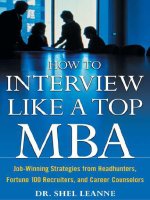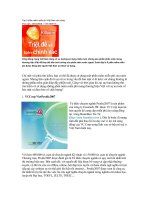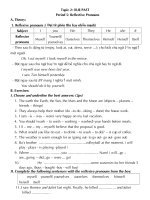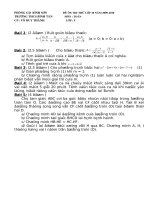Getting into a Top 5 MBA Program doc
Bạn đang xem bản rút gọn của tài liệu. Xem và tải ngay bản đầy đủ của tài liệu tại đây (176.08 KB, 14 trang )
Getting into a Top 5 MBA Program
A brief guide for applicants to
Harvard, Kellogg, MIT Sloan, Stanford, Wharton
and other leading business schools
This document has been prepared by a group of graduates of various top US business schools, now
working for an international strategy consulting firm. It is intended as an information resource for our
colleagues considering applying to business school in the future. We encourage you to choose which
schools are right for you and investigate them thoroughly before applying.
Why a Top MBA?
Unlike graduates of medical schools and law schools, there is no licensing exam required
to practice business in the United States. In addition, the quality of accredited schools
offering MBA degrees varies tremendously. This is a degree you can obtain part-time in
4 years, in an executive program in 1 year, via correspondence courses, and from schools
with near 100% acceptance rates.
As a result, the value of your MBA degree is directly related to the prestige of the
university and business school which grants it. A recent study of the value of MBA
programs concluded that “if you don’t get into a leading business school, the economic
value of the degree is really quite limited.”
1
The study examined consultants at McKinsey
& Company and investment bankers at Goldman, Sachs & Co. and found that those
without MBA’s performed as well, or better, than business school graduates. The fallacy
of the study was that it did not recognize that it is much harder to get such a job without
an MBA degree. Intellectual horsepower and potential – rather than business knowledge
– is the primary criterion top consulting firms and investment banks look for. If someone
possesses a Ph.D. in economics from MIT or a JD from Harvard – quite common at such
firms – then that obviously serves as a more than adequate intellectual proxy for even a
top two-year MBA.
The required curriculum at most business schools consists of courses such as finance,
accounting, statistics, organizational behavior, strategy, economics, communications and
technology. Schools may have a larger or smaller set of “core” courses, and many give
these subjects different names. But overall, MBA programs have more similarities with
one another than they do differences, and most of the same subjects are taught from the
same textbooks, using many of the same cases.
Thus, the academic content of a business school education – much like a law school or
medical school education – does not vary greatly between programs. But due to the
tremendous variation in the standards of institutions conferring the degree, an MBA has
1
Professor Jeffrey Pfeffer, Stanford Graduate School of Business.
the most value in the marketplace when it is from a school that is highly respected. In
addition, the lifelong professional network which comes from going to business school is
more valuable when it is from a school where graduates typically go on to the most
successful careers.
The Top 5 Programs
There is no other academic degree which is ranked and analyzed by so many publications
and organizations as the MBA. While the most well-known rankings – US News and
BusinessWeek – have been published for more than 10 years, new rankings from the
Financial Times, Forbes and the Wall Street Journal have come out recently. US News is
generally considered the best ranking, as their system is the most transparent, and their
rankings always come closest to peoples’ common sense perception of relative prestige.
There are three schools which have been ranked #1 by US News in the past ten years –
Stanford Graduate School of Business, Harvard Business School, and the Sloan School of
Management at MIT.
None of these schools have ever been ranked #1 by BusinessWeek. Instead, the only
schools to achieve the top position in their ranking are the Wharton School of the
University of Pennsylvania, and the Kellogg School of Management at Northwestern
University. While the Financial Times has only published rankings for the past three
years, it also uses relatively transparent criteria, and is respected as a ranking. The only
schools to hold the #1 position in its ranking have been Harvard and Wharton. The five
schools mentioned stand out amongst their peers, and when a straight average of all
schools’ rankings in US News, BusinessWeek and the Financial Times are taken, the top
5 schools with their average ranks are:
Business School Rank US News
Business
Week
Financial
Times
1
University of Pennsylvania: Wharton
1.7
3 1 1
2
Harvard Business School
2.3
2 3 2
3
MIT: Sloan
4.7
4 4 6
4
Stanford University GSB
5.0
1 11 3
5
Northwestern University: Kellogg
5.3
5 2 9
The Forbes rankings attempt to quantify the benefit of each program on the basis of 5-
year monetary gain, and came out with a ranking which has Harvard as #1 and the other 4
schools all in the top 10. The problem with the Forbes methodology – regardless of how
close their resultant rankings may be to those from other publications – is that the benefit
of a given degree cannot be measured only by net present value, and even that criterion
needs to be measured over the course of one’s career rather than just the first 5 years after
business school.
The Wall Street Journal uses only one criterion – recruiter satisfaction – and produces
some of the strangest rankings, with Stanford ranked #45, Sloan #38, Wharton #18,
Harvard #8, Kellogg #5, and Dartmouth’s Tuck School of Business ranked #1. Their
ranking disagrees dramatically with nearly every other ranking, and is generally not
considered valid due to some contradictions in their methodology. The primary
acknowledged problem with the Wall Street Journal’s system is that graduates of top
business schools are often only interested in the most sought-after companies, and many
less prestigious companies gave schools like Sloan and Stanford low marks because they
had a difficult time attracting graduates of those programs to accept their job offers.
The complete list of the top 25 MBA programs and their average ranking on the basis of
US News, BusinessWeek and the Financial Times looks like this:
School Name Avg. Rank
US News
‘02
Business
Week ‘00
Financial
Times ‘02
1
University of Pennsylvania: Wharton
1.7
3 1 1
2
Harvard Business School
2.3
2 3 2
3
MIT: Sloan
4.7
4 4 6
4
Stanford University GSB
5.0
1 11 3
5
Northwestern University: Kellogg
5.3
5 2 9
5
Columbia University GSB
5.3
6 7 3
7
University of Chicago GSB
7.3
9 10 3
8
Duke University: Fuqua
9.0
6 5 16
9
NYU: Stern
11.0
13 13 7
9
University of Virginia: Darden
11.0
10 9 14
11
Dartmouth College: Tuck
11.7
9 16 10
12
Michigan
12.0
10 6 20
12
Cornell: Johnson
12.0
16 8 12
14
UCLA: Anderson
13.7
15 12 14
14
U.C. Berkeley: Haas
13.7
10 18 13
16
Yale University
14.3
13 19 11
17
U. of North Carolina: Kenan-Flagler
16.7
17 15 18
17
Carnegie Mellon University GSIA
16.7
18 14 18
19
U. of Texas at Austin: McCombs
21.3
18 17 29
20
Purdue University: Krannert
28.3
28 25 32
21
Ohio State: Fisher
31.7
24 31 40
21
University of Maryland: Smith
31.7
43 27 25
23
Southern Methodist University: Cox
34.0
34 31 37
24
Michigan State: Broad
35.0
24 29 52
25
Notre Dame: Mendoza
38.0
34 31 49
It should be noted that Columbia achieves the same average ranking using this measure
as Kellogg (although it is listed after it since the list is sub-sorted by median rank). The
University of Chicago is also not far off at #7. In fact, the deans of Harvard, Kellogg,
Sloan, Stanford, Wharton, Columbia and Chicago, meet regularly to share benchmarking
information, and generally consider each other to be peer schools. The reason that
Columbia and Chicago are generally not considered top 5 is because they are just slightly
less prestigious, as reflected in a couple of key statistics. Columbia used to have a 46%
acceptance rate just 8 years ago, far higher than any other top school, letting in nearly 1
out of every 2 applicants. Meanwhile, Chicago even now has around a 50% yield every
year – in other words, nearly half of the people offered admission to Chicago choose not
to attend. Nonetheless, these two schools are considered among the most prestigious after
the top 5, and are even ranked in the top 5 in some finance-heavy rankings.
Yield – that is, the % of students who accept offers of admission – is another key
indicator of the quality of a program. While some less prestigious programs may have
high yields because of a highly targeted audience, the top 25 programs are certainly
competing with one another for many of the same students. In other words, the typical
explanation for someone turning down an offer of admission at one top business school is
because they accepted the offer of a school they would rather attend. Since top candidates
receive more offers of admission, their choice of program is a factor which can be used to
gauge the quality of each program. The top schools by yield are the same schools at the
top of the average publication’s rankings:
School Name Yield Acceptance Rate ‘03
1
Harvard Business School
85% (est.)
12%
2
Stanford University GSB
83%
9%
3
MIT: Sloan
75%
18%
3
University of Pennsylvania: Wharton
75%
15%
5
Columbia University GSB
71%
13%
6
Northwestern University: Kellogg
66%
16%
7
University of Chicago GSB
58%
28%
Salary – graduates of the best programs tend to make the most money, but salaries must
be measured over the course of time, since starting figures can be misleading. Although
no publication has undertaken such a survey, Forbes 5-year measure – the 2000 salary of
the class of 1996 – is the best indicator of average post-graduate earning potential:
School Name
2000 Salary,
Class of 1996 Pre-MBA Salary
1
Columbia University GSB
$202,000
$45,000
2
Harvard Business School
$195,000
$48,000
3
University of Pennsylvania: Wharton
$188,000
$45,000
4
MIT: Sloan
$180,000
$50,000
5
University of Chicago GSB
$170,000
$43,000
6
Dartmouth College: Tuck
$166,000
$47,000
7
Stanford University GSB
$150,000
$50,000
7
Northwestern University: Kellogg
$150,000
$47,000
9
NYU: Stern
$140,000
$39,000
10
UC Berkeley: Haas
$136,000
$47,000
Schools like Columbia and NYU are, of course, ranked higher in this list because of the
large number of people who self-select into investment banking and other high
remuneration finance careers, and generally choose careers in New York City where the
cost of living is much higher as well. But the list shows the same logic as the other tables.
Endowment – this is kind of like the market capitalization of a business school, in a
somewhat silly way. If a school has many graduates who have gone on to become very
wealthy, it should have a lot of money in its endowment fund. If the school is well-
managed, that fund should grow and help it attract more successful students. These are
the top 10 schools by endowment in BusinessWeek’s 1999 statistics survey:
School Name
Endowment ($
millions)
Endowment per
student ($ 000)
1
Harvard Business School
1100
628
2
MIT: Sloan
402
560
3
Stanford University GSB
387
530
4
Northwestern University: Kellogg
380
152
5
University of Pennsylvania: Wharton
338
216
6
Michigan
267
138
7
Virginia: Darden
255
523
7
Yale
255
607
9
University of Chicago GSB
207
87
10
Dartmouth College: Tuck
167
420
The reason the per-capita endowment figures for schools like Chicago and Kellogg are so
low is because they spread their resources amongst a large number of full-time and part-
time students. Harvard, MIT, Stanford and Wharton do not have part-time programs.
Famous Alumni – so who goes on to fame and fortune with an MBA degree? Besides
George W. Bush, the nation’s first MBA president (Harvard ‘75), the most prominent
MBA’s are CEO’s of the world’s largest companies. MBA Jungle analyzed the Fortune
200 to see where their CEO’s went to school. The list, once again, has the top schools
well-represented, and shows Harvard’s strength historically:
School Name # of Fortune 200 CEO’s
1
Harvard Business School
20
2
MIT: Sloan
5
3
Stanford University GSB
4
3
Columbia University GSB
4
3
University of Chicago GSB
4
6
NYU: Stern
3
7
Northwestern University: Kellogg
2
7
University of Virginia: Darden
2
7
Emory: Goizueta
2
7
Indiana University: Kelley
2
7
University of Texas: McCombs
2
In the past 100 years, Harvard has been the most popular destination for those interested
in an MBA. Of course, the MBA was a completely different animal just 20 years ago.
Back then, most students went directly out of college, and the competition and prestige
were nothing like it is today. It is worth noting that only 79 CEO’s in the Fortune 200 had
MBA degrees at all – but the MBA accounted for more than two-thirds of all graduate
degrees held by these CEO’s. Although Wharton only had 1 CEO in the Fortune 200,
they have historically had more, and this particular ranking is always in a state of flux.
The rest of this document will focus on the top 5 programs, but the same principles apply
to the admissions process at most top 10 or top 20 programs.
Keys to Admission
Your GMAT score, undergraduate GPA, and the number of years of work experience you
possess are the primary quantitative indicators used by business school admissions
committees. Here is how the top 5 schools stack up on those measures:
Business School
Median
GMAT
Median
GPA
Work Experience
(Years)
Stanford University GSB
730
3.5 5
MIT: Sloan
710
3.5 5
Harvard Business School
700
3.5 4
University of Pennsylvania: Wharton
700
3.5 5
Northwestern University: Kellogg
700
3.5 5
As of this writing, this means that more than half of all students attending these schools
scored in the top 5% of all GMAT test takers worldwide. It also means that somewhat
less than half did not. The GMAT is the primary indicator of raw intellectual ability
considered by admissions committees, since it is standardized, and offers an objective –
albeit incomplete – measure of ability between students from different colleges and
majors. If you are lower than your target school’s average on any of these measures, it
should be compensated by all of the other areas. In other words, if you expect to get in to
Wharton with only 2 years of full-time work experience, you should have a very high
GMAT score and GPA amongst other things.
Retaking the GMAT – this is only useful if your highest score is below your target
school’s median. Retaking the GMAT to get a 730 when you already have a 710 is
reasonably meaningless and shows you to be focused on the wrong things. Of course,
getting a 720 after previously scoring a 670 may greatly help your candidacy. While most
schools say you can take the GMAT as many times as you want, you should never take
the test without proper preparation, as the entire process can be quite arduous. Prepare by
taking practice tests – particularly CAT simulations – and if you find that you are not
scoring 700+ with regularity, you should consider taking a course to prepare.
Although admissions committees at top schools say that a low GMAT score won’t keep
you out, those who get in with scores in the low 600’s are almost certainly exceptional
cases. If you are the average candidate without any internationally impressive
accomplishments, a low GMAT score almost guarantees you a dreaded “ding” letter. On
the other hand, for the candidate who is average in all other respects, a 790 isn’t much
different from a 740 from the school’s point of view. Most schools will admit two
otherwise similar candidates with disparate but high GMAT scores based on
characteristics other than the GMAT. As for the people who get in with scores from 650
to 700, admissions can be frustratingly random – even more so than for everyone else.
While the overall GMAT score is what will be counted most heavily, the quantitative
score is more important for applicants with non-technical backgrounds while the verbal
score is examined more closely for applicants from foreign countries and those with
science or engineering degrees. Schools are merely looking for the assurance that a
candidate will be able to both crunch numbers and communicate well. Assuming that the
overall GMAT score is alright, only a seriously low score on the section that will be
examined most closely for a given candidate would be a liability. For example, if you are
a native english speaker and have good grades from an Ivy League college in Literature,
they probably won’t be too concerned about a low score on the verbal section, and just
consider it an aberration. However, a low score on the quantitative section – regardless of
how strong your combined GMAT score is – could be a major liability. The AWA score
is not important for most applicants, and is not factored into the overall GMAT score
anyway. In some cases, the actual text of the AWA section might be compared to an
applicant’s essays if the schools are skeptical about either’s authenticity.
How the GPA is evaluated – top business schools are not as focused on undergraduate
grades as other professional programs. If you have a 99
th
percentile LSAT score, and a
4.0 GPA in Political Science from Princeton, you will almost definitely get into Yale Law
School. If you score 9.2 on the MCAT and graduate with a 3.4 in music, you will almost
definitely not get into Johns Hopkins Medical School. On the other hand, if you graduate
first in your class in finance at NYU, get a 780 on the GMAT, and work at Boston
Consulting Group for three years, the admissions committee at Stanford Business School
could decide they’ve already let in enough people like you, and the spot could go to
someone with a 3.2 GPA in English who worked in a NGO in Africa. The bottom line is
that if you are still in school, you should try to get the very best grades you can, but
afterwards you just have to live with them. If you did poorly in undergraduate, good
graduate degree grades help offset the impression that you’re incapable of getting good
grades, but they don’t undo the damage your GPA does to the school’s average. Thus,
letting you in becomes a very context and timing-driven judgment call.
Essays – there are typically two to seven essay questions in each application, with
between 2000 and 3000 words required in total. While the first application will take you
the longest, and you can cut-and-paste many paragraphs into subsequent essays, overall
the differing nature of school’s questions will require you to spend many days on each
package to create a satisfactory product. The essays are your primary opportunity to
convince the school to let you in. They will evaluate you on two dimensions: what you
will bring to the school as an MBA student, and what you will bring to the school as an
alumnus. The second criterion is obviously the most important. Schools are trying to
select the applicants they believe will be the most successful in their careers based on
their backgrounds and accomplishments to date. Put another way, the 10-20% of
applicants who get into a top business school are the ones who least needed the top MBA
degree to succeed in their careers. Ironic, but true.
Of course, most of the applicants to top schools are reasonably successful in their careers
already, so your essays need to distinguish you from others in your peer group. Your peer
group – those applicants who are most like you – is who you are competing against
primarily. For example, any top school could fill up their entire class with analysts from
consulting firms with high GMAT scores and GPA’s. But they won’t. Instead, they will
have a certain number of spots for such applicants, and someone who was a sculptor
would not be competing for one of those spaces. This makes some peer groups more
competitive than others in any given year. Most schools will say that every candidate
competes against every other candidate, and from a certain point of view this is true.
Someone could be a consultant, and even though they have already let in more
consultants than they would like, he could bring something so special to the class from
other experiences that they decide to let him in too. But in such a situation, the candidate
likely won’t get in on strong numbers alone.
Your essays also give the school a sense of your personality. They want to see how you
work your argument and the reasons they should admit you into your writing – while still
answering their questions directly. They want you to be able to list and explain your
accomplishments without being boastful or off-topic. These are, of course, the same skills
you will need to be successful in your career after graduation.
Many people have taken to using admissions and essay consultants, and most schools will
tell you that they discourage this. It is our opinion that the vast majority of successful
candidates do not use paid essay editing services, and the majority of those who do use
such services do not get in. This makes sense, of course – the people that need those
services the most are the weakest candidates, and they’re on their own when it comes to a
final interview. But beyond that, admissions consultants are invariably not the kind of
people that a candidate to a top school wants advice from. Most did not ever attend a top
business school themselves, and those few that did were essentially not successful
enough to find reasonable jobs afterwards – and thus got into the essay editing business.
We encourage you to get someone else to look at your essays and make suggestions, but
pick someone who isn’t being paid on the basis of how much of your time they take, or
how many changes they suggest you make. Perhaps there’s nothing wrong with your
essays at all!
On the other hand, you should collect as much information and advice on the admissions
process as you can, but always take it with a grain of salt. An unsuccessful applicant may
not always be right about why they didn’t get in, but alumni of a given school can usually
give you a pretty accurate picture of what it takes to get in. Written information sources
are also essential, and this guide assumes that you’ve probably already picked up Richard
Montauk’s excellent book, “How to Get Into The Top MBA Programs”. Although his
advice is more generic – and thus applicable to any MBA program, but not customized
for the truly best programs – you need to learn everything about the process. You should
use that book with this guide to tune your application for top 5 schools.
Recommendations – these are most certainly the least important part of your application,
but you shouldn’t discount them. They should reinforce what their rest of your package
says, and provide the opinion of a real person who knows you very well and can answer
the school’s questions directly and honestly. Every school will tell you this, and you
should listen. The truth is that school’s know that many applicants write their own
recommendations and just get their recommenders to sign and send them.
When to apply – the earlier the better, in general. Schools have either 2 or 3 application
deadlines (rounds) and round 3 is almost always incredibly difficult to get in. This is just
because statistically, there are very few spots left open by the third round. While some
people believe that round 2 can be best for candidates without extremely strong
backgrounds, it’s our belief that the first round is the best if you can get your application
up to a desirable standard of quality in time.
The Interview – Harvard, Sloan, Stanford and Wharton all interview candidates by
invitation only. This means that if you receive an interview – and at Harvard and Sloan,
nearly all accepted candidates are required to interview – then this is your last and best
opportunity to convince the admissions committee that you are someone they would like
to have at their school. At Kellogg, all applicants are required to interview, so this
changes the dynamic of the session significantly. Instead of the interview being an
opportunity for you to address any weaknesses and convince them to let you in, it is
merely another data point taken with the rest of your application. Put another way, a
strong interview at Kellogg can’t get you in – but a weak interview can, and will, keep
you out.
Conclusion
Attending one of the top business schools in the United States is really an amazing
experience that we would recommend to anyone. Our classmates from business school
are some of our closest friends, and the value of the network after graduation is
immeasurable. We believe that you will be best served by attending the very best school
you can get into, so never set your sights too low for reasons of expense, geography or
other hassles.
Take a risk, and apply to some great programs – you won’t regret it.
Good luck!
Harvard Business School
Harvard University
Boston, Massachusetts
HINTS
Harvard is obsessed with leadership, and they are looking for indications of
leadership ability in each of their candidates. This can be in the form of managerial
work experience, extracurricular activities, or initiative taken in other forms. What
is more important than demonstrated leadership is to convince them that you have
the capability for taking on great responsibility and taking charge of a situation in
the future. Harvard is considered the #1 general management school by US News
(and most of the world), so personal well-roundedness is key.
FAMOUS ALUMNI SAMPLE
George W. Bush, President, United States of America
Louis Gerstner, Chairman, IBM Corporation
Rajat Gupta, Worldwide Managing Director, McKinsey & Company
Jeffrey Immelt, CEO, General Electric Company
Jeff Skilling, Former CEO, Enron Corporation
ADMISSIONS STATISTICS
Application Rounds: 3 – October 17, 2002; January 7, 2003; March 11, 2003
Class Size: 910
Applicants: 8,893
Waitlist Size: NOT RELEASED
Waitlist Acceptance Rate: NOT RELEASED
FINANCIAL AID
Annual budget: $54,800
Guaranteed loans available for all students.
FURTHER INFORMATION
BusinessWeek Profile
/>
Harvard MBA Admissions
Kellogg School of Management
Northwestern University
Evanston, Illinois
HINTS
Kellogg believes that teamwork is what builds great organizations, and the ability to
work with, and co-exist with others in the business school environment is their
primary screening criterion. Kellogg is ranked as the #1 school for marketing, so
communications ability and softer skills are more valued here – and expected – than
at other top programs. As was mentioned earlier, the interview has a different nature
at Kellogg than at other schools, and they want to see if you are the Kellogg “type”,
and excited about their program specifically.
FAMOUS ALUMNI SAMPLE
Michael Borman, President, Blue Martini Software
Leland Brendsel, CEO, Freddie Mac
John Hoeven, Governor, State of North Dakota
James Keyes, CEO, Johnson Controls
Locke Burt, Senator, State of Florida
ADMISSIONS STATISTICS
Application Rounds: 3 LAST YEAR – Nov. 9, 2001; Jan. 14, 2002; Mar. 15, 2002
Class Size: 625
Applicants: 6,039
Waitlist Size: NOT RELEASED
Waitlist Acceptance Rate: NOT RELEASED
FINANCIAL AID
Annual budget: $52,533
Guaranteed loans available for all students.
FURTHER INFORMATION
BusinessWeek Profile
/>
Kellogg MBA Admissions
MIT Sloan School of Management
Massachusetts Institute of Technology
Cambridge, Massachusetts
HINTS
Sloan wants to admit a class of innovators. What is most important is to convince
the admissions committee that your career will involve having a great impact on
your organization or industry, and that you have the creativity and courage to take it
on great challenges. Sloan is ranked the #1 school for technology, operations
management and quantitative analysis, so strong business analytical skills are
expected, but communications ability is what distinguishes successful applicants.
FAMOUS ALUMNI SAMPLE
Kofi Annan, Secretary-General, United Nations
Carly Fiorina, CEO, Hewlett-Packard Corporation
William Ford, CEO, Ford Motor Company
Benjamin Netanyahu, Former Prime Minister, Israel
John Reed, Former Chairman, Citigroup Corporation
ADMISSIONS STATISTICS
Application Rounds: 2 – November 6, 2002; January 29, 2003
Class Size: 319
Applicants: 2,940
Waitlist Size: 208
Waitlist Acceptance Rate: 15%
FINANCIAL AID
Annual budget: $55,310
Guaranteed loans available for all students.
FURTHER INFORMATION
BusinessWeek Profile
Sloan MBA Admissions
/>
Stanford Graduate School of Business
Stanford University
Stanford, California
HINTS
With the highest average GMAT score in the world and the lowest acceptance rate,
Stanford is the most difficult business school to gain admission into on the basis of
numbers alone. That being said, they have a very diverse class mix and a balance
curriculum that emphasizes both hard and soft skills. The key to admission is
convincing the committee that you are bringing something unique to the class.
While Stanford is not ranked #1 in any sub-specialty, it is strong in many areas.
FAMOUS ALUMNI SAMPLE
Steve Ballmer, CEO, Microsoft Corporation (dropped out after 1 year)
John Donahoe, Worldwide Managing Director, Bain & Company
Philip Knight, CEO, Nike Corporation
Scott McNealy, CEO, Sun Microsystems
Charles Schwab, Chairman, Charles Schwab Corporation
ADMISSIONS STATISTICS
Application Rounds: 3 – October 30, 2002; January 8, 2003; March 19, 2003
Class Size: 378
Applicants: 5,253
Waitlist Size: 243
Waitlist Acceptance Rate: 9%
FINANCIAL AID
Annual budget: $48,012
Guaranteed loans available for all students.
FURTHER INFORMATION
BusinessWeek Profile
Stanford MBA Admissions
/>
Wharton School
University of Pennsylvania
Philadelphia, Pennsylvania
HINTS
The Wharton School is ranked as the #1 school in finance and accounting, and their
emphasis is definitely on business fundamentals. Although the class has the same
number of years of work experience as at other top programs, the average age
skews a little higher, and thus maturity is definitely valued by the admissions
committee. The admissions committee at Wharton is looking for talented, hard-
working individuals that have achieved a great deal but are not arrogant about it.
FAMOUS ALUMNI SAMPLE
Reginald Jones, Former CEO, General Electric Company
Shaun O’Malley, Former Chairman, PriceWaterhouseCoopers, LLP
Louis Platt, Former CEO, Hewlett-Packard Corporation
Donald Trump, CEO, Trump Organization
Gary Wilson, Chairman, Northwest Airlines
ADMISSIONS STATISTICS
Application Rounds: 3 LAST YEAR – Nov. 8, 2001; Jan. 3, 2002; Mar 14, 2002
Class Size: 771
Applicants: 7,274
Waitlist Size: 371
Waitlist Acceptance Rate: 23%
FINANCIAL AID
Annual budget: $59,728
Guaranteed loans available for all students.
FURTHER INFORMATION
BusinessWeek Profile
Wharton MBA Admissions
/>









